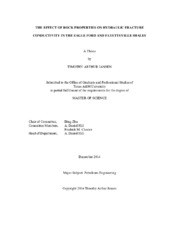The Effect of Rock Properties on Hydraulic Fracture Conductivity in the Eagle Ford and Fayetteville Shales
Abstract
Hydraulic fracture treatments are used in low permeability shale reservoirs in order to provide highly conductive pathways from the reservoir to the wellbore. The success of these treatments is highly reliant on the created fracture conductivity. Optimizing fracture designs to improve well performance requires knowledge of how fracture conductivity is affected by rock and proppant characteristics.
This study investigates the relationship between rock characteristics and laboratory measurements of propped and unpropped fracture conductivity of outcrop samples. These samples are from the Eagle Ford shale and the Fayetteville shale. Triaxial compression tests were performed on core specimens in order to determine the Young’s Modulus and Poisson’s Ratio of the outcrop samples. A combination of X-ray diffraction and Fourier transform infrared spectroscopy was used to determine the mineralogy. Profilometer surface scans were also performed to characterize the fracture topography.
The results from this study show that the main factors affecting fracture conductivity are closure stress and proppant characteristics (concentration, size, and strength). For unpropped fractures, the fracture topography is the main factor in determining fracture conductivity. The topography interaction of the two surfaces determines the fracture width. A higher Young’s Modulus helps maintain this fracture width by resisting deformation as closure stress increases. For propped fractures, the most influential factor in determining fracture conductivity is proppant characteristics (concentration, size, and strength). At a proppant monolayer
placement, the major mechanism for conductivity loss is proppant embedment, leading to decreased fracture width. A higher Young’s Modulus reduces the proppant embedment and better maintains fracture conductivity as closure stress increases. For a multilayer proppant
pack concentration, the effect of rock characteristics is negligible compared to the effect of proppant pack characteristics.
Citation
Jansen, Timothy A (2014). The Effect of Rock Properties on Hydraulic Fracture Conductivity in the Eagle Ford and Fayetteville Shales. Master's thesis, Texas A & M University. Available electronically from https : / /hdl .handle .net /1969 .1 /153882.


